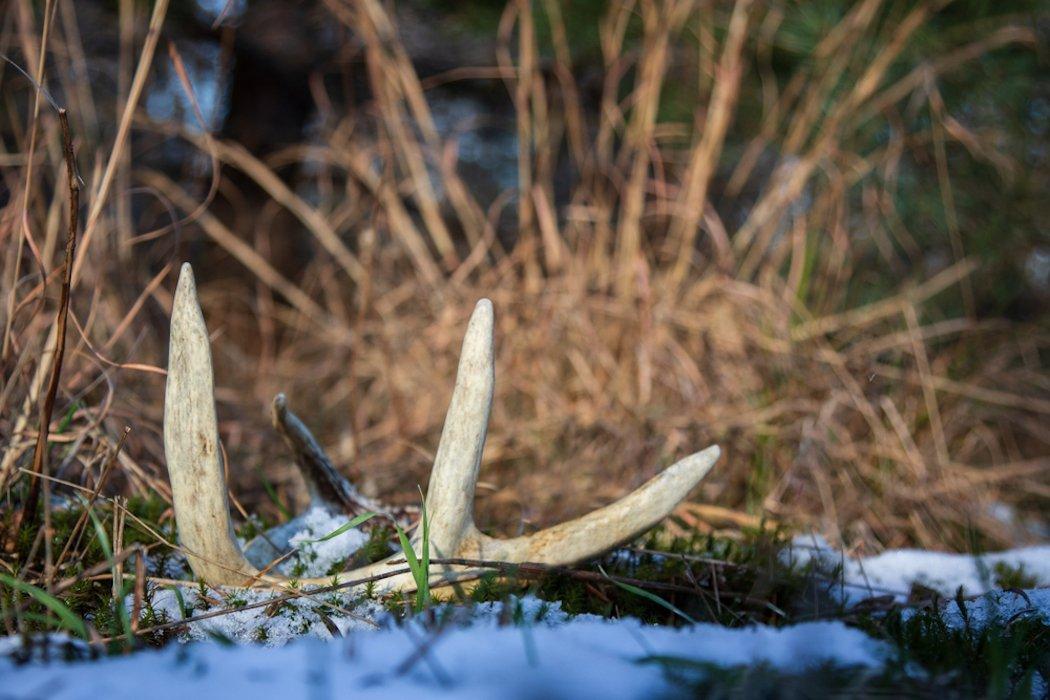Have You Fallen for Any of These?
Shed hunting ‚ it's a hobby that gets in your blood, thoughts and every other orifice of your mental being. Like other forms of hunting, it consumes you, if you let it. Don't let it. But do enjoy it. And while you do, make sure you learn as much about it as possible. The more you learn, the better at it you'll become.
Part of that initiative is to weed out good information from the bad. And while I'm no deer shed biologist, I've walked a lot of miles in search of white gold. I've found my fair share of it. And I've noticed trends that matched up to findings of other like-minded individuals throughout the years. Naturally, myself and others have formulated opinions based on consistent and repetitive discoveries that helped us determine what we believe to be shed hunting myths. Here are five of those.

I've heard some people say all of the bucks shed at the same time. That theory is extremely easy to disprove. I know just this past season that some bucks began dropping in December and others won't do so until March or April. That's just the way it is.
My point from this myth ‚ don't assume that the bucks have shed in your area just because other people have said as much has happened where they are. Antler shedding is extremely relative ‚ as much or more so than the rut itself. Always confirm with trail cameras and glassing from afar to determine if antlers have dropped in your area. You don't want to move in to shed hunt before they do.
Don't Miss: How to Find Shed Antlers
Photo Credit: Shutterstock / Donald Roczkowski

I commonly hear others say that cold weather is the primary trigger for the antler drop. While that's certainly a factor, and can be linked to antler shedding, the research seems to suggest that antler casting is triggered by decreasing testosterone levels ‚ and not the mercury level in the temperature gauge.
Now, as mentioned, temperature levels, rigors of the rut, body condition, overall health and other things can contribute to testosterone levels decreasing. But the actual trigger itself is a testosterone threshold that must be reached to commence the degrading (dissolving) process within the pedicle.
Don't Miss: 5 Tips from a 12-Year-Old Shed Hunting Master
Photo Credit: Shutterstock / Bikenbark

It seems everything I read these days points to creek, fence and ditch crossings as the best places to find sheds. It's true these locations are solid spots to find antlers. I've said as much myself. But to think these are the best locations is folly.
Sure, any place that a deer rubs, jumps or jars itself is a place an antler could detach. But I urge you to think about shed antlers in terms of the amount of time a deer spends in given locations. Sheds are most likely to be where deer spend the most time. That's the simple truth.
Don't Miss: 10 Reasons You Suck at Shed Hunting
Photo Credit: Shutterstock / Jason Yoder

Again, a lot of shed hunting literature would have you believe bedding areas are the only places to find shed antlers. It is true that bedding cover is likely the best place to find them. I've found approximately 75 percent of my sheds in such locations. But don't forget everywhere else, too.
Food sources, water sources, major and minor trails and other key areas are great spots to find sheds as well. And when you find sheds in repeated locations, remember those places, because unless habitat or circumstances change, they'll likely be good spots to check for years to come.
Don't Miss: 12 Things You Should Know Before Shed Hunting
Photo Credit: Shutterstock / Donald Roczkowski

When you find these dead heads, you'll likely want to throw them in the truck with your sheds and take them home with you. But you can't. At least, not without doing something else first. Most states require you to get a tag for a dead head before you can pick it up and take it home.
Here in Kentucky, the law requires for a game warden to come out, inspect the site where you find the dead head, and then provide you with a tag. That's what I had to do when I found the two dead heads last year. That said, not all states require that. Check the regulations where you shed hunt to make sure you're in compliance with all game laws.
Kentucky Department of Fish and Wildlife Resources Conservation Officer Brad Bowles provided additional insight into the process.
In Kentucky, you are required to contact your local conservation officer to obtain a carcass tag for any deer head you find and want to possess, Bowles said. There are many things in nature that may result in a deer dying: disease, injury, or a poorly placed shot by a hunter. In most cases, officers will investigate how a person has come into possession of the deer rack. I usually instruct the person to take photos of the deer carcass with their cell phone without moving or altering the location the deer was found. Oftentimes, this will provide some explanation for how the deer died. It also may be helpful if several deer in the area are found dead for our biologists to determine whether there is need for concern with any disease outbreaks, such as the case we recently experienced in eastern Kentucky. After reviewing all of the available evidence, the conservation officer still has discretion on whether or not to issue a carcass tag.
Happy shed hunting. And here's to hoping you find sheds instead of dead heads.
Don't Miss: Why Everyone Who Says Shed Hunting Is Useless Is Wrong
Photo Credit: Josh Honeycutt
Are you a deer hunter wanting to learn how to accomplish your goals? Check out our stories, videos and hard-hitting how-to's on deer hunting.






